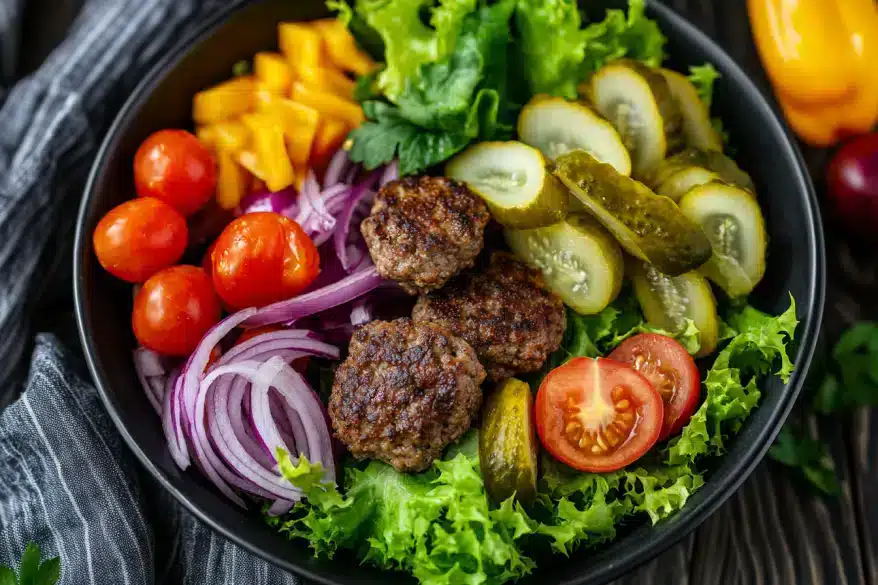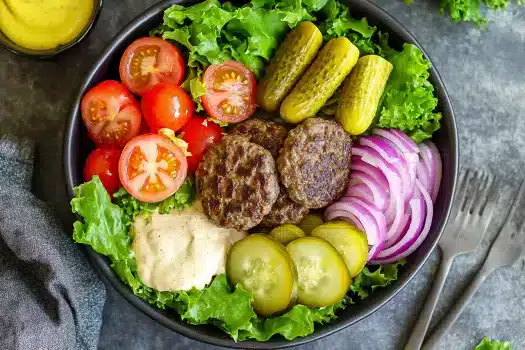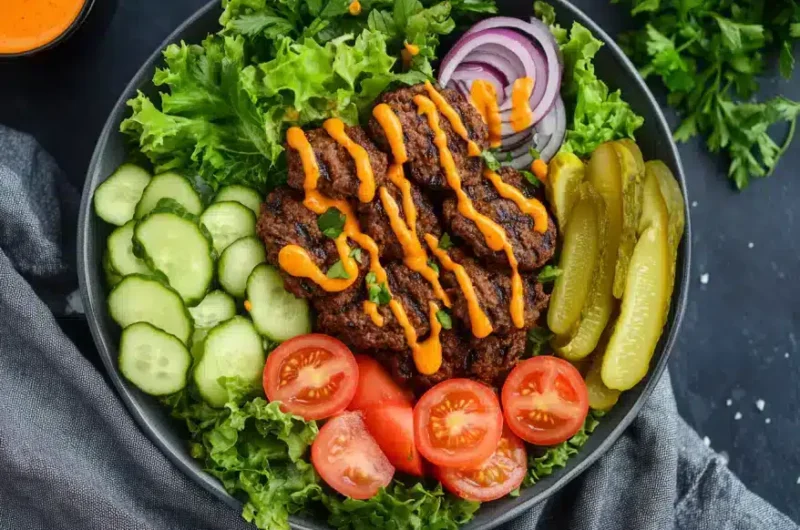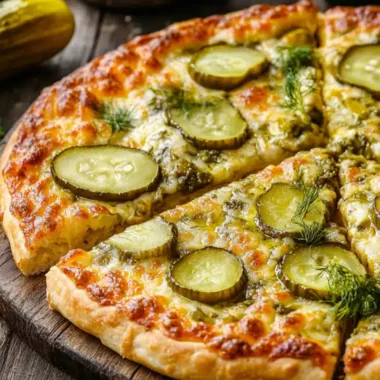Imagine savoring each bite of a traditional burger without feeling weighed down by a heavy bun—or regret! The burger bowl recipe revolutionizes your mealtime routine by artfully arranging lean ground beef, crisp lettuce, vibrant vegetables, and creamy sauces into one tempting dish. In fact, this cleverly deconstructed burger bowl merges the best aspects of a hearty burger with the lively, refreshing qualities of a salad. Moreover, it allows room for personalization—so, whether you’re aiming for a keto burger bowl, seeking gluten-free alternatives, or simply craving a lighter twist, you’ll find myriad options right here. Let’s dive in and discover how easy, satisfying, and downright fun it can be to build your own burger bowl, experimenting with ingredients, exploring flavor profiles, and uncovering the secrets to crafting a meal that’s both irresistibly delicious and remarkably simple.
Understanding the Burger Bowl Recipe Concept
When it comes to enjoying a hearty meal that simultaneously feels light and fresh, burger bowl recipes sure steal the show. But what exactly sets them apart from conventional burgers, and why are they suddenly all the rage?
What is a Burger Bowl Recipe?
The Rise of the Burger Bowl Trend: Believe it or not, this fad didn’t just pop up out of thin air. Rather, it evolved as food enthusiasts began seeking creative ways to relish familiar flavors without clinging to the same old delivery method. Although you might love a classic burger now and then, the heavy bun, coupled with greasy sides, can sometimes leave you feeling sluggish. By contrast, deconstructed burger bowls capture the essence of a burger’s core components—succulent ground meat, crisp produce, and tangy sauces—while sidestepping stodgy bread. Thus, the dish appears as both a nutritional upgrade and a refreshing way to switch things up.
How Deconstructed Burger Bowls Differ from Traditional Burgers: Traditional burgers typically center around a patty tucked inside a bun. In a bunless burger bowl, however, you dispense with the bread and place all the elements into a bowl: think crunchy lettuce, bright cherry tomatoes, and savory cheese shreds all dancing together in perfect harmony. Yet, the key difference lies not only in presentation. Indeed, a burger bowl encourages customization, nutrient density, and inventive flavor combinations that range far beyond your everyday burger joint offerings.
Why Choose a Bunless Burger Bowl Over a Regular Burger?
Surely, the most compelling reason involves health and taste. For one thing, a burger bowl recipe delivers the satisfaction of a juicy patty but without the empty carbs of a bun. Furthermore, you gain a stunning array of colorful veggies and fresh toppings instead of a monotone stack of bread, patty, and cheese. Consequently, you’ll enjoy a textural tapestry that’s crisp, tender, creamy, and tangy all at once. Moreover, you have the liberty to tweak, twist, and tailor every element—ensuring that each forkful bursts with flavor.
Key Components of a Burger Bowl
At its core, a burger bowl resembles a well-curated salad composed of your favorite burger ingredients. With that said, choosing the right ingredients plays a huge role in achieving mouthwatering results.
Selecting the Lean Ground Beef or Alternatives: Start by opting for quality ground beef that’s not overly fatty. Alternatively, consider turkey, chicken, or even plant-based crumbles if you’re exploring lighter or more sustainable proteins. For more information on safe handling, ensure you follow Safely handling ground beef guidelines to maintain top-notch quality and flavor.
Choosing Crisp, Fresh Greens: Romaine Lettuce, Mixed Greens: At the heart of every fantastic burger salad bowl lies a bed of fresh greens—romaine or mixed greens that supply crunch, brightness, and a subtle backdrop for bolder flavors. After all, these greens create the perfect canvas for adding layers of textures and colors.
Vibrant Vegetables: Cherry Tomatoes, Red Onions, Cucumbers: Embrace seasonal produce bursting with flavor. Cherry tomatoes add sweetness, while red onions contribute a sharp, pungent bite. Cucumbers, too, lend a cool crispness that balances rich, savory elements. Because fresh produce is crucial, consider referencing Food safety best practices to keep your veggies fresh and clean.
Savory Accents: Dill Pickles, Cheese Shreds, Avocado Slices: Distinguish your bowl by including tangy dill pickles, creamy avocado slices, and shredded cheese that melts on contact with warm meat. For extra tips on crafting exceptional creamy toppings, you might also find inspiration in Creamy Avocado Sauce Tips.
The Perfect Homemade Sauce Drizzle: Don’t forget a signature sauce—a harmonious blend of zesty mustard, tangy vinegar, and smooth mayo or Greek yogurt. That final drizzle can tie every component together, ensuring no single ingredient feels out of place.
Nutritional Benefits of a Burger Bowl Recipe
A burger bowl recipe doesn’t merely taste good; it also nourishes your body in ways a standard burger might not.
Lower Carb and Weight-Loss Friendly Options: Without a starchy bun hogging center stage, you slash empty calories. This simple tweak can support your nutritional goals, especially if you’re watching your carb intake or trying to shed a few pounds.
High-Protein and Nutrient-Dense Elements: Lean ground beef or alternative proteins ensure you’re packing in muscle-building amino acids. Meanwhile, leafy greens and vegetables bring vitamins, minerals, and antioxidants to the table.
Balanced Macros in a Burger Salad Bowl: The balanced mix of protein, healthy fats (from avocado or dressings), and carbohydrates (from veggies) helps stabilize blood sugar and keep you feeling full longer. Ultimately, that means you can enjoy a burger bowl both as a comforting lunch and as a smart dinner choice after a busy day.
Essential Ingredients for the Perfect Burger Bowl Recipe
When approaching your burger bowl recipe, let’s face it: one of the keys to unlocking its culinary potential lies in choosing top-notch, flavor-packed ingredients. After all, each component—whether it’s the protein, the fresh produce, or the vibrant toppings—plays a starring role. Moreover, focusing on carefully sourced, high-quality elements not only heightens the taste experience but also ensures that every forkful bursts with wholesome goodness. So, before rushing into kitchen adventures, consider how selecting specific meats, veggies, and accents can make a remarkable difference in your final creation.
Selecting Quality Meat for Your Burger Bowl Recipe

Choosing Grass-Fed Beef and Its Benefits:
Start with the centerpiece—your protein. Although regular ground beef works just fine, grass-fed varieties typically deliver richer flavors, leaner composition, and higher nutritional value. Indeed, they’re often brimming with beneficial fatty acids and a more natural, robust taste. Coupled with the freedom to season and shape it to your heart’s desire, this option makes a burger bowl feel like a gourmet treat, even if you’re just cooking at home. Remember, you’ll want to brush up on proper Portion control guidelines so you don’t overindulge in even the tastiest of ingredients.
Exploring Other Proteins: Turkey, Chicken, Plant-Based Options:
Still, beef isn’t everyone’s go-to. In fact, it’s quite simple to swap in lean ground turkey or chicken for a lighter twist. These choices yield tender, mild flavors that pair beautifully with bold seasonings. If you’re craving something more innovative, plant-based proteins—like lentil-and-mushroom blends or crumbled soy patties—offer a delightful meatless spin. By selecting alternatives, you not only meet the needs of various diets but also discover entirely new flavor pathways.
Seasoning and Marinating Your Meat:
Of course, even the highest-quality meat deserves a thoughtful seasoning strategy. Begin by mixing in salt, pepper, garlic powder, and perhaps a hint of paprika to deliver a gentle kick. Consider marinating overnight in a simple blend of vinegar, herbs, and olive oil for an extra layer of complexity. Just ensure that your chosen marinade complements, rather than overwhelms, the natural flavor of your protein.
The Freshness Factor: Picking the Right Vegetables
Crisp Greens for a Flavorful Base:
At the heart of your burger salad bowl sits a lush, verdant bed of greens. Try crisp romaine for its sturdy texture that supports heavier toppings. Alternatively, mixed greens bring a delicate, nuanced flavor profile that harmonizes with rich meats and tangy sauces. Whichever you choose, be certain they’re fresh, clean, and well-dried to maintain that signature crunch.
Juicy, Ripe Tomatoes for Tangy Sweetness:
Few things enliven a meal like a perfectly ripe tomato. By selecting bright cherry tomatoes or full-bodied heirloom slices, you’ll impart a sweet, juicy note that contrasts beautifully with savory patties. In fact, that gentle acidity enlivens your bowl, making every bite taste balanced and juicy.
Onions and Pickles for Bright, Punchy Tastes:
Next, add aromatic onions—thin-sliced red onions lend a sharp bite, while milder scallions or chives soften the intensity. Meanwhile, crisp dill pickles supply a tangy pop that complements rich proteins and creamy dressings, ensuring your bunless burger bowl doesn’t lack personality.
Enhancing Flavor with Cheese and Other Toppings
Selecting Cheese: Cheddar, Swiss, Dairy-Free Alternatives:
For those who enjoy dairy, a sprinkle of shredded cheddar or a slice of Swiss melds seamlessly with warm meat. The resulting creaminess accentuates each mouthful, adding a comforting dimension. If you’re avoiding dairy, fear not—there are plenty of plant-based cheese alternatives that deliver delightful creaminess without compromising on taste.
Adding Creaminess with Avocado or Guacamole:
Avocado slices or a dollop of guacamole bestow silky richness and heart-healthy fats that transform your bowl into a luscious feast. Plus, their mild flavor aligns perfectly with robust seasonings, lightly sweet tomatoes, and crisp lettuce. Even a small amount elevates the overall texture to luxurious heights.
Textural Contrast with Nuts or Seeds (Optional):
If you’re feeling adventurous, sprinkle in some crushed walnuts or pumpkin seeds. These subtle additions introduce a pleasant crunch and layer of complexity, pushing your burger bowl beyond traditional burger territory and into a realm of gourmet delight.
Savory Homemade Sauces and Tangy Dressings:
Finally, don’t forget that distinctive finishing touch. Crafting a homemade sauce—perhaps a yogurt-mustard blend or a creamy avocado-lime dressing—helps tie every component together. Aim for a balance of tang, sweetness, and mild heat, ensuring your sauce complements rather than masks the fresh ingredients. From simple drizzle to showstopping signature sauce, dressing is your chance to shine.
Step-by-Step Instructions for Crafting Your Burger Bowl Recipe

You’ve gathered your prime ingredients—now it’s time to transform them into a dazzling masterpiece. Although it might feel intimidating at first, assembling a deconstructed burger bowl proves refreshingly simple once you understand the process. In fact, crafting your burger bowl recipe can feel downright meditative as you chop vibrant veggies, sizzle aromatic patties, and artfully arrange each element until it all sings in perfect harmony.
Prepping the Meat
Forming Patties or Crumbling Ground Beef:
First things first: decide whether you’ll be using patties or crumbled meat. Forming small patties allows for a neat, classic burger-style presentation—just press seasoned ground beef, turkey, or plant-based protein into patty shapes and cook them evenly. On the other hand, crumbled meat works beautifully if you crave a looser texture that mingles effortlessly with the greens, tomatoes, and other toppings. Either approach adds savory depth that anchors your burger salad bowl.
Achieving Perfect Doneness:
Moreover, keep a keen eye on cooking temperatures. While you don’t want raw meat, overcooking leads to dryness and disappointment. Aim for a medium doneness in beef patties, or thoroughly cook poultry-based options without stripping away their moisture. A good rule of thumb: press lightly on the patty and feel for gentle resistance—too springy indicates rawness, while rock-hard suggests it’s overdone. After cooking, let them rest a few moments to preserve those flavorful juices.
Assembling Your Burger Bowl
Layering the Greens and Vegetables:
With your protein prepped, turn your attention to bowl assembly. Start by spreading a generous layer of crisp greens as your base. Next, scatter on those juicy tomatoes, vibrant onions, and tangy pickles. This bottom layer sets the stage, ensuring each subsequent element stands out.
Placing the Meat Strategically for Maximum Flavor:
Now, position your warm patties or savory crumbles atop the veggie bed. If using patties, slice them for easier mixing, or keep them whole to create a dramatic centerpiece. Crumbled meat can be sprinkled evenly, ensuring a harmonious flavor distribution that hits every forkful. The warmth of your protein slightly wilts the greens, blending textures and aromas into a cohesive, mouthwatering bite.
Drizzling with Homemade Burger Sauce:
Before calling it a day, drizzle a generous spoonful of your chosen sauce over the top. This final flourish brings the entire dish together, pooling in nooks and crannies and uniting the flavors. Go ahead—give it a taste. If it’s missing some brightness, add a squeeze of lemon or a hint of vinegar; if it needs richness, add another spoonful of sauce or a few avocado slices.
Garnishing and Serving Suggestions
Choosing the Right Bowl or Plate:
In truth, presentation matters more than you might think. Selecting a wide, shallow bowl allows for easy mixing and a pleasing aesthetic, so every colorful ingredient shows off. Alternatively, a large plate works if you prefer a more deconstructed, spread-out look.
Accompaniments: Sweet Potato Fries or Roasted Veggies:
Though this bunless burger bowl can stand alone, why not serve it with a side that adds further contrast? Crispy sweet potato fries lend subtle sweetness and a hearty crunch. Roasted veggies—think zucchini, bell peppers, or mushrooms—offer earthy notes that complement the fresh greens. Together, they form a complete, satisfying meal.
Presenting with a Culinary Twist:
Don’t hesitate to get creative. Garnish with fresh herbs, sprinkle on a pinch of sesame seeds, or add edible flowers for a gourmet flourish. The aim is to highlight the bowl’s vibrant hues and varied textures, making it as visually enticing as it is delicious. Indeed, a beautifully arranged deconstructed burger bowl inspires you to savor each bite slowly, appreciating the symphony of flavors dancing across your taste buds.
Customizing Your Burger Bowl Recipe
Now that you’ve mastered the basics, it’s time to kick your burger bowl recipe up a notch. After all, one of the most appealing aspects of this dish lies in its adaptability. Whether you adhere to a specific dietary approach, crave unexpected flavor profiles, or simply want to experiment with bold seasonings, customizing your burger salad bowl makes each meal feel like your own special creation. By tweaking a few key components, you’ll discover endless opportunities to personalize and refine this dish—ensuring it never grows dull.
Dietary Preferences and Modifications
Keto Burger Bowl Variations (Low Carb):
For anyone embracing a low-carb lifestyle, the keto burger bowl offers a remarkable solution. Swap high-carb toppings—such as starchy sides—for nutrient-dense, low-glycemic vegetables. Add extra healthy fats like sliced avocado and perhaps a dollop of full-fat Greek yogurt sauce. Meanwhile, choose a full-fat cheese and rely on meat or plant-based protein to maintain satiety. This way, you’ll enjoy a flavorful, comforting bowl that aligns with your dietary goals, without feeling restricted.
Gluten-Free and Grain-Free Alternatives:
Those avoiding gluten or grains will appreciate how naturally accommodating a bunless burger bowl can be. Since there’s no bun to begin with, you sidestep one of the main gluten culprits. Just ensure that any sauces, marinades, or seasonings are gluten-free. Instead of breadcrumbs to bind your patties—if you’re making them from scratch—use almond flour or crushed gluten-free crackers. Within minutes, you’ll have a grain-free meal bursting with fresh flavors.
Dairy-Free and Vegan Options:
Who says you need animal products to savor a deconstructed burger bowl? By opting for plant-based crumbles or marinated tofu, you achieve a satisfying, protein-rich foundation. Top it off with vegan cheese alternatives, creamy avocado-based sauces, and a wide array of crisp veggies. In truth, the adaptability of this dish can make going dairy-free or vegan feel like an opportunity rather than a sacrifice.
Flavor Profiles from Around the World
Mediterranean-Style Deconstructed Burger Bowl:
Eager for a taste of the sun-soaked shores of the Mediterranean? Add olives, roasted red peppers, and a crumble of feta (or dairy-free equivalent). Infuse your protein with garlic, oregano, and a hint of lemon zest. Complete the picture with a drizzle of tangy Greek yogurt sauce for an ensemble that sings with bright, fresh notes.
Tex-Mex Inspired Bunless Burger Bowl:
Craving bolder, spicier flavors? Stir in black beans, chopped jalapeños, or roasted corn kernels. Season your meat with cumin, chili powder, and smoked paprika. Top it off with a dollop of guacamole and a drizzle of lime-infused Greek yogurt dressing. This Tex-Mex spin delivers a zesty punch, perfect when you want to shake up your routine and savor something a bit adventurous.
Asian-Inspired Umami Flavors:
For a dish infused with global flair, consider an Asian-inspired approach. Marinate your protein in soy sauce or tamari, ginger, and a hint of sesame oil. Add thinly sliced cucumbers, shredded carrots, and a sprinkle of toasted sesame seeds. Garnish with a dollop of a tangy soy-ginger dressing, and suddenly, your burger salad bowl transcends boundaries, becoming a truly international feast.
Adjusting Seasonings and Dressings
Spicy Kick with Jalapeños:
If you crave heat, don’t hold back. Incorporating pickled or fresh jalapeños spikes the intensity, transforming a mild burger bowl into a fiery, flavor-packed experience. Adjust the amount to suit your tolerance—just remember that you can always add more, but toning down excessive spice can be tricky.
Creamy Greek Yogurt Sauces:
On the other hand, if you yearn for smooth, mild creaminess, introduce a Greek yogurt-based sauce. Mix in fresh herbs, lemon juice, and a touch of garlic. This approach yields a refreshing drizzle that tames spicy elements, brightens heavier components, and underscores the crisp freshness of your veggies.
Zesty Mustard-Based Dressings:
For a distinct tang, whip up a mustard-based dressing, blending Dijon or whole-grain mustard with olive oil, vinegar, and perhaps a spoonful of honey for balance. Drizzle it over the entire bowl, and watch as the flavors harmonize into a lively, invigorating medley.
Tips for Perfecting Your Burger Bowl Recipe
Now that you’ve got your customization ideas, you might wonder how to consistently nail every aspect of your burger bowl recipe. From choosing the right tools to refining cooking techniques and maintaining proper food safety, a few key pointers can elevate your dish from good to exceptional. After all, small tweaks here and there can sharpen your kitchen prowess and help you craft a well-rounded, unforgettable meal.
Choosing the Right Tools and Kitchen Essentials
Proper Knives for Chopping Vegetables:
Let’s start with the basics. Using a sharp, high-quality knife ensures clean cuts, uniform veggie slices, and a more visually appealing final presentation. Besides, properly chopped produce not only looks better but also provides textural consistency—no more gnawing on unwieldy carrot chunks or wrestling with uneven tomato wedges.
High-Quality Skillet or Grill Pan:
Upgrading your skillet or grill pan makes a substantial difference when cooking patties or crumbled meat. A well-seasoned cast-iron skillet or a non-stick, heavy-bottomed pan ensures even heat distribution, helping you avoid undercooked centers or scorched exteriors. With the right tools, your protein emerges tender, juicy, and just the right level of charred.
Storage Containers for Meal Prep:
If meal prep is on your radar, consider investing in reliable storage containers. Airtight, stackable options let you portion ingredients ahead of time and keep them fresh. This step can significantly reduce weekday stress—simply toss your prepped items into a bowl, top with your protein and sauce, and voilà: a ready-made burger salad bowl in minutes.
Cooking Techniques for Best Results
Pan-Searing vs. Grilling Your Patties:
When it comes to cooking techniques, experiment with pan-searing or grilling your patties. Pan-searing in a hot skillet produces a crisp, caramelized crust and locks in juices. On the other hand, grilling lends a smoky, summery essence that amplifies natural flavors. Either way, consider brushing your patties lightly with oil and seasoning them just before cooking for maximum flavor impact.
Ensuring Even Cooking and Juiciness:
No one loves a dry, rubbery patty. To ensure even cooking, let your protein rest at room temperature for a few minutes before tossing it into a blazing pan. Additionally, flip the patties only once and avoid pressing down on them with your spatula, which can squeeze out precious juices. Patience pays off when it comes to tender, succulent meat.
Quick Tips for Meal Prep and Batch Cooking:
If you love simplifying your weeknight dinners, cook extra patties or crumbled meat in advance. Store them separately from the veggies and greens to preserve freshness. When it’s time to dine, warm the protein, assemble the bowl, and finish with your choice of dressing. This streamlined approach transforms a potentially tedious meal into a quick, easy, and always-satisfying option.
Maintaining Food Safety and Quality
Safe Internal Temperatures for Ground Beef:
Food safety trumps all else. Use a meat thermometer to confirm that ground beef has reached a safe internal temperature (generally 160°F or 71°C). Although it might seem tedious, this step ensures you enjoy your burger bowl without worrying about undercooked protein.
Washing and Drying Produce Thoroughly:
Clean produce is non-negotiable. Rinse leafy greens, cucumbers, tomatoes, and onions under cool running water. Pat them dry thoroughly or use a salad spinner to prevent sogginess in your bowl. Pristine ingredients enhance the flavor and texture, making every crisp, clean bite a pleasure.
Storing Leftovers and Reheating Properly:
When you have leftovers, separate the meat, veggies, and sauce to maintain texture and taste. Store them in airtight containers and reheat the protein gently over low heat. Don’t forget to add a fresh drizzle of sauce or a handful of greens for rejuvenation. This method ensures yesterday’s burger salad bowl still hits all the right notes today.
Pairing and Serving Your Burger Bowl
By now, you’ve assembled and perfected your burger bowl recipe, yet you might still feel something’s missing. Perhaps you’d like a complementary side dish that contrasts with the main event’s rich flavors, or maybe you’re wondering how best to serve it to delight your loved ones. Fortunately, presenting and pairing this dish involves as much creativity and intuition as selecting the ingredients. In fact, by thoughtfully choosing side options, beverages, and plating techniques, you can elevate your deconstructed burger bowl from a quick weeknight fix to a showstopping centerpiece.
Complementary Side Dishes
Roasted Vegetables and Fresh Salads:
Sometimes, the simplest additions create the greatest impact. Consider serving roasted vegetables—like zucchini, carrots, or colorful peppers—to amplify the bowl’s freshness. Their caramelized sweetness and tender texture contrast beautifully with crisp greens and savory meats. Alternatively, a refreshing side salad, bursting with herbs, cherry tomatoes, and maybe a dash of extra dressing, can round out the meal. After all, balancing flavors and textures transforms the experience from ordinary to extraordinary.
Crispy Sweet Potato Fries or Plantain Chips:
If you crave something crunchy to accompany your bunless burger bowl, try pairing it with sweet potato fries. These orange-hued beauties deliver natural sweetness, a hearty bite, and a subtle complexity that aligns perfectly with savory patties. Or, opt for plantain chips for a slightly exotic twist. Serving a small handful of these sides on the same plate creates a captivating interplay of flavors, ensuring that every bite offers a new surprise.
Light Soups or Broths:
For those times when you want to lighten the mood, consider a gentle, aromatic soup. A clear vegetable broth or a mild miso-based soup complements the burger salad bowl without competing for attention. Such a pairing soothes the palate, adding warmth and comfort while letting the main dish’s flavors remain at the forefront.
Beverage Options (Non-Alcoholic)
Sparkling Water with Citrus:
Want to keep it simple and refreshing? Serve your burger bowl with sparkling water infused with a squeeze of lemon or lime. The effervescent bubbles and zesty citrus notes cleanse your palate after each savory bite, making the entire meal feel cleaner, brighter, and more invigorating.
Iced Herbal Teas:
Iced herbal teas offer a subtle, aromatic note that doesn’t overshadow the meal. Mint, chamomile, or hibiscus teas provide mild sweetness or floral undertones. In doing so, they pair elegantly with the fresh produce and savory proteins in your burger salad bowl, encouraging slower, more mindful savoring of each forkful.
Fresh-Squeezed Juice or Smoothies:
For a burst of vitamins and cheerful color, consider fresh-squeezed juice—perhaps carrot-apple or cucumber-lime. Alternatively, whip up a light, green smoothie with spinach, cucumber, and a hint of ginger. These nutrient-dense beverages augment the dish’s healthfulness while delivering a subtle sweetness that harmonizes with its savory base.
Presentation and Styling
Colorful Garnishes for Visual Appeal:
Remember, we eat with our eyes first. By garnishing your deconstructed burger bowl with bright herbs—like cilantro or parsley—and a sprinkling of sesame seeds, you create a colorful, appetizing panorama. Try slicing veggies diagonally or layering ingredients thoughtfully to highlight contrasts. These small touches build excitement before the first bite even reaches your tongue.
Plating Techniques to Impress Guests:
If you’re serving friends or family, consider arranging the bowl family-style. Place each topping in its own section, allowing diners to build their perfect mouthful. Alternatively, assemble multiple smaller bowls with slight variations—maybe one focuses on spicy jalapeños while another highlights creamy avocado sauce—inviting guests to sample and compare. By doing so, you turn your burger bowl recipe into an interactive culinary adventure.
Personalizing Bowls with Family-Friendly Add-Ons:
Think about who’s at the table. If kids are involved, consider mild flavors, crunchy elements they enjoy, and perhaps a fun dipping sauce on the side. For adults, feel free to experiment with more daring seasonings or global flavors. This adaptability ensures that everyone at the table savors their meal, reinforcing the belief that a bunless burger bowl can be as flexible and welcoming as it is delicious.
Troubleshooting Common Issues with a Burger Bowl Recipe
As easy as assembling a burger bowl recipe might seem, occasionally, you’ll stumble upon small hiccups that thwart culinary perfection. Perhaps your meat turned out dry, or the flavors didn’t quite mesh as you’d hoped. Not to worry—these common problems have simple fixes. By diagnosing the cause and making a few strategic adjustments, you’ll soon move past these setbacks and return to enjoying a satisfying, flavor-packed meal.
Avoiding Dry or Overcooked Meat
Cooking Times and Temperature Adjustments:
If your patties come out as tough as old boots, consider reducing cooking time or lowering the heat. A meat thermometer is your best friend—pull the protein off the heat as soon as it reaches the recommended safe internal temperature. Letting it rest for a few minutes redistributes juices, ensuring that your finished product is tender and succulent.
Adding Moisture with Sauces and Vegetables:
If dryness persists, double down on moisture. A drizzle of creamy dressing, a spoonful of mashed avocado, or a few extra tomato slices can all contribute juiciness. Even a simple squeeze of lemon or lime juice can brighten flavors and counteract dryness, transforming a lackluster bowl into a mouthwatering masterpiece.
Pre-Seasoning and Resting the Meat:
Before cooking, season your meat generously and let it sit for a short while. This rest period allows the flavors to penetrate deeper and encourages natural moisture retention. By ensuring the protein is fully seasoned and rested, you often prevent dryness before it starts.
Balancing Flavors and Textures
Toning Down Overly Spicy Elements:
If the bowl sets your mouth ablaze, temper the heat with cooling additions. Add more lettuce, cucumber, or a dollop of yogurt-based sauce to calm the spiciness. Balancing out spices ensures your meal remains enjoyable rather than punishingly hot.
Bringing Brightness to Flat Tastes:
When the flavors feel dull, inject brightness with acidity and freshness. A squeeze of lemon, a splash of vinegar, or an extra handful of vibrant herbs instantly rejuvenates flat notes. Rather than resigning yourself to blandness, embrace these quick fixes to keep the experience lively and intriguing.
Enhancing Creaminess Without Extra Fat:
If you crave creaminess but aim to limit fat, think outside the box. Blended silken tofu, pureed roasted vegetables, or a yogurt-based sauce all add a smooth, luxurious texture without weighing down the bowl. This delicate balance ensures that you maintain your health goals while still indulging in a delicious meal.
Keeping It Fresh and Appealing
Choosing Seasonal Produce:
If your bowl feels predictable or tired, try rotating the produce according to what’s in season. Swap out cherry tomatoes for juicy, sun-ripened heirlooms in the summer, or add roasted root vegetables in cooler months. By staying in tune with nature’s cycles, your burger salad bowl evolves throughout the year, keeping you excited about what’s next.
Rotating Greens and Veggies:
If romaine lettuce isn’t cutting it anymore, switch to spinach, arugula, or even kale. Similarly, trade cherry tomatoes for diced bell peppers, or add shredded carrots for extra crunch. Continual small changes ensure your bunless burger bowl always feels fresh, surprising, and satisfying.
Trying Different Sauces and Dressings:
Stuck in a sauce rut? Experiment! A tangy balsamic dressing, a creamy tahini drizzle, or even a simple olive oil-herb mixture can shift the flavor dynamic. By occasionally changing the dressing, you introduce new flavor profiles that reignite your passion for this endlessly adaptable dish.
Frequently Asked Questions (FAQs) on Burger Bowl Recipe
While a burger bowl recipe often speaks for itself, some questions naturally arise as you dive deeper into this culinary trend. Whether you’re curious about health, storage, or ingredient swaps, these frequently asked questions aim to clear the air, helping you approach your next mealtime adventure with confidence.
Is a Burger Bowl Healthy?
Yes, a bunless burger bowl can be quite healthy, as it typically includes nutrient-dense vegetables, lean proteins, and healthy fats. By skipping the bun, you cut down on refined carbohydrates, making it a more balanced and colorful meal.
Can I Make a Burger Bowl Ahead of Time?
Definitely! Prep your vegetables, cook your protein, and store them separately. When ready to eat, assemble and top with sauce. This makes it ideal for busy weekdays when you need a quick, nourishing meal.
What’s the Best Type of Meat for a Burger Bowl?
Lean ground beef works beautifully, but turkey, chicken, or plant-based crumbles also shine. Choose according to your dietary preferences and desired flavor profile.
How Do I Store Leftover Burger Bowls?
Keep components separate—meat in one container, veggies in another—to maintain freshness. When reheating, warm the protein gently, then reassemble with crisp greens and a fresh drizzle of sauce.
Can I Freeze Burger Bowl Ingredients?
Yes, you can freeze cooked patties or crumbled meat. Fresh vegetables don’t freeze well, so add them fresh after thawing your protein.
What Toppings Work Best in a Burger Bowl?
Endless possibilities await! Try avocado slices, pickled onions, grilled mushrooms, shredded cheese, or crunchy nuts. The sky’s the limit.
How Do I Make a Burger Bowl Vegan?
Simply replace meat with plant-based protein, skip dairy-based cheese, and use vegan sauces. Load up on veggies, legumes, and nuts for texture, flavor, and protein.
Is a Burger Bowl Gluten-Free?
A deconstructed burger bowl is naturally gluten-free when you choose gluten-free seasonings and dressings. As always, double-check labels to ensure no hidden gluten slips in.
How Long Does It Take to Prepare a Burger Bowl?
With basic prep, assembling can be done in under 30 minutes. Meal prep can shorten that time even further, making this dish a go-to option when you’re short on time.
Do I Need Special Tools to Create a Burger Bowl?
Not really. A sharp knife, a sturdy cutting board, a good skillet or grill pan, and a big bowl suffice. Additional gadgets, like a salad spinner, help streamline the process but aren’t essential.
Can I Add a Sweet Element to My Burger Bowl?
Certainly! A handful of dried cranberries, a drizzle of honey-lime dressing, or a few slices of fresh fruit can introduce a subtle sweetness that offsets savory flavors.
How Do I Prevent Sogginess in My Burger Bowl?
Dry your greens thoroughly and add sauce just before serving. Layering sturdier veggies at the bottom also helps keep the top layers crisp and lively.
Conclusion and Encouragement to Experiment
You’ve journeyed through every facet of the burger bowl recipe: from understanding its concept and selecting ingredients to mastering customization, troubleshooting, and pairing strategies. What’s left? Embrace your newfound culinary confidence and start experimenting! By approaching each bowl as a personal canvas, you’ll discover that this dish is as much about fun, exploration, and self-expression as it is about nourishment and flavor.
Dare to tweak seasonings, incorporate global twists, or swap out greens and sauces. After all, the beauty of a deconstructed burger bowl lies in its endless possibilities. Whether you’re whipping one up for a quick lunch, meal-prepping for a busy week, or showcasing your kitchen prowess at a family gathering, relish in the freedom to innovate. In time, you’ll craft a signature version that perfectly matches your taste buds, lifestyle, and culinary dreams—proving that healthier, tastier, and more satisfying meals can indeed be right at your fingertips.






